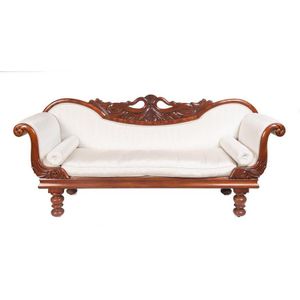Mahogany Double Ended Chaise Lounge with Claw Feet
You must be a subscriber, and be logged in to view price and dealer details.
Subscribe Now to view actual auction price for this item
When you subscribe, you have the option of setting the currency in which to display prices to $Au, $US, $NZ or Stg.
- Claw Feet - Carved or cast in the shape of a lion's claw or the talons of other more fabulous beasts. They may be found on chair and table legs, supporting platform bases, and cabinets in the Classical Revival manner. Claw feet are not uncommon on Australian furniture made throughout the 1850s and 1860s, though, as with all forms of carving, the deeper and richer the claws are carved, the earlier the piece is likely to be.
- Rail - A term used by cabinet makers for the horizontal sections of the frame of an item such as a chair or settee which have a front rail, a back rail and two side rails, and also on a door or carcase, where the rails are joined to the vertical framings.
- Mahogany - Mahogany is a dense, close grained red-coloured timber from the West Indies and Central America. It was first imported into Europe in the the early 18th century and its use continued through the 19th century. It was popular for furniture making because of its strength, the wide boards available, the distinctive grain on some boards, termed flame mahogany and the rich warm colour of the timber when it was polished.. The "flame" was produced where a limb grew out from the trunk of the tree, and this timber was usually sliced into veneers for feature panels on doors, backs and cornices.
Some terms used to describe mahogany relate to the country from which it originally came, such as "Cuban" mahogany, "Honduras" mahogany etc. However unless the wood has been tested the names assigned are more a selling feature, rather than a true indication of the timber's origin.
This item has been included into following indexes:
Visually similar items

Mid 19th century blackwood nursing chair with inswept sabre legs

A Colonial cedar swan neck double ended settee upholstered in a cream silk fabric, circa 1840. 103 cm high, 223 cm wide, 62 cm deep

A Victorian Queen Anne style mahogany two seater couch late 19th century. The couch is decorated with scrolls and shells in the Queen Anne style, upholstered in green velvet covering. Height 92 cm; width 110 cm; Depth 70 cm

A good late 19th century mahogany framed two seater parlour settee, the restrained scroll back with button detail, scroll carved arms with acanthus leaf detail, short conforming legs, pale gold/green silk self-patterned brocade type upholstery with rope br
